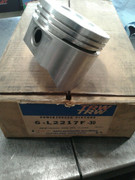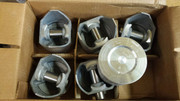the 200 vs 250 debate is very alive with small block ford six enthusiasts for good reason. Both engines offer their advantages. Basic SBF-Six is a robust platform and forced induction addition is not too complicated.
the modest OEM compression ratios of the 200/250 are adaptable easily to low to mid boost applications. U.S. heads are mostly same and plenty of forum - data on mods.
not having any engineering degree or personal machine shop, I study the data, do the math, and build with my resources and budget.
my favorite machinist always tells me:
"... your choice, it's just horsepower per your cubic dollar... "
Although the 200 uses same integral intake cylinder head, the 250 basically is the stroked version of the 200 and the added rod length adds to the piston speed and reciprocating forces as well as increasing usable torque/
powerband. The 'under-box' bore/stroke of the 7 mains contribute to a anvil strong bottom end. 250 stroke is .784 " longer than 200.
Current SC'd 250 runs up to 5-8 lbs easily with occasional enthusiasm well over 10 so far... I had machinist check but not mill head to retain OEM D3xx large compression chambers (@ 60cc's). With 'modern' @.045 composite gskt, SCR is @ 8.7:1.
![[IMG] [IMG]](/proxy.php?image=https%3A%2F%2Fi.postimg.cc%2FRqmKr65R%2FIMG-0934.jpg&hash=5aebdfe9181b750c28035228327d817d)
.
![[IMG] [IMG]](/proxy.php?image=https%3A%2F%2Fi.postimg.cc%2FcrMM91mT%2FIMG-1510.jpg&hash=77e82bed14cd6634ab3373cf6aae306f) @ 3 yrs - 5K miles with available boost.
Ford Small Block Six 250 CID inline . Stock block and cam with blueprinted matched 60 cc chamber head, HD V8 valve springs, ARP head bolts. Holley 2300 - 7448 2Bbl heavily modified for blow-through/ boost, Aeromotive 1:1 boost referenced regulator and FI electric pump and return at tank. Flame Thrower rev-limited HEI ignition - DS II distributor modified for vac and centrifugal boost advance limiting. Vortech V-2 centrifugal supercharger with pulley ratio spec’d for inline six 250' powerband. Centerforce weighted clutch, T5-Z 'Cobra' 5 Speed, 3.80 rear. AM radio and bench seat.
@ 3 yrs - 5K miles with available boost.
Ford Small Block Six 250 CID inline . Stock block and cam with blueprinted matched 60 cc chamber head, HD V8 valve springs, ARP head bolts. Holley 2300 - 7448 2Bbl heavily modified for blow-through/ boost, Aeromotive 1:1 boost referenced regulator and FI electric pump and return at tank. Flame Thrower rev-limited HEI ignition - DS II distributor modified for vac and centrifugal boost advance limiting. Vortech V-2 centrifugal supercharger with pulley ratio spec’d for inline six 250' powerband. Centerforce weighted clutch, T5-Z 'Cobra' 5 Speed, 3.80 rear. AM radio and bench seat.
earlier turbo 250 had Buick derived Draw-Thru setup on OEM block and worked head.
.
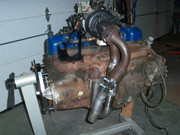
.
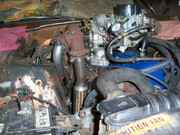
.
Started with getting engine running well NA, next added turbo and significant ignition timing mods. slowly increased boost and carb tuning for
safer AFR's until boosting
too optomistic at over 1 bar.. ... .
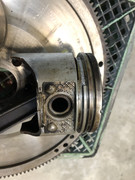
.
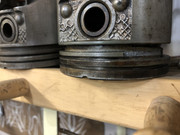
have fun

![[IMG] [IMG]](/proxy.php?image=https%3A%2F%2Fi.postimg.cc%2FRqmKr65R%2FIMG-0934.jpg&hash=5aebdfe9181b750c28035228327d817d)
![[IMG] [IMG]](/proxy.php?image=https%3A%2F%2Fi.postimg.cc%2FcrMM91mT%2FIMG-1510.jpg&hash=77e82bed14cd6634ab3373cf6aae306f)




